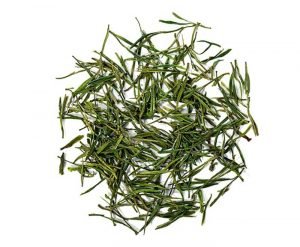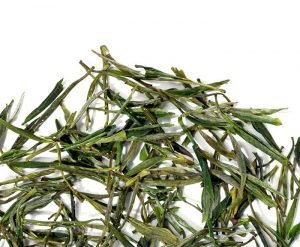What characterizes an authentic Anji Bai is that the leaves turn ‘white’ when steeped.
Is Anji White Tea a Green Tea?
Yes. Even though the name is confusing, Anji Bai Cha is processed according to green tea processing methodology. Therefore it’s indeed a green tea. ‘White’ refers to the Camellia Sinenses plant type that is more white than other tea plants from other tea regions.
Where is Anji Bai Cha produced in China?
As the name already reveils, this white tea is produced in Anji. This county is part of the Huzhou prefecture in Zhejiang province with a population of about 450,000. By taking advantage of their favorable environment and climate, the Anji community is able to develop pollution-free green products, such as bamboo shoots, green tea, alpine vegetables, and flowers. The Chinese government also designated Anji as a pilot county for ecological and green building construction.
How to steep Anji Bai Cha?
Anji white tea MUST be steeped at low temperatures due to its delicacy. Steep this tea around 80 °C – 175 °F for an optimal infusion. Steeping time should be around 3 minutes but can be adjusted according to taste.
What are the health benefits of white tea from Anji?
Recent research suggest that there are many health benefits related to white tea consumption. In addition, white tea from Anji is 100% produced in a natural environment from from any pollution. However, as tea lovers we want to say this: don’t buy this tea if you only care about the health benefits. This tea is a real tea connoisseur level tea, buy it to experience the amazing taste. Otherwise it’s a waste, really.
History & Origin of Anji Bai Cha
The term ‘white tea’ or ‘bai cha’ was first mentioned all the way back in the Tang Dynasty. Lu Yu, today regarded as China’s ‘tea saint’, mentioned in his book ‘The Classics of Tea’ that there’s a ‘white tea mountain’ east of Yongjia County, where the tea leaves are as white as paper and consumed by the common folks.
Later during the 12th century, ‘white tea’ was mentioned again in emperor Huizong’s ‘Da Guan Cha Lun’ (Perspective on Tea) in which he described it as a tea plant with jade white leaves.
Many experts, believe that both Lu Yu and Huizhong were referring to the white coloured tea plant that is used today to process Anji Bai Cha.
More Information
| Steeping time | 4-5 min |
|---|---|
| Steeping temperature | 80 °C – 175 °F |
| Leaves per 500ml / 17oz teapot | 2-5 gram |
| Tablespoons / 500ml (17 oz) | 1.5 tbsp |
| Harvest Year | 2022 |
| Tea Season | Spring |
| Tea Caffeine Content | low |
| Tea Region | Anji Village |
| Tea Province | Zhejiang |
| Gluten-free | yes |
| Tea in Chinese | 安吉白 |














